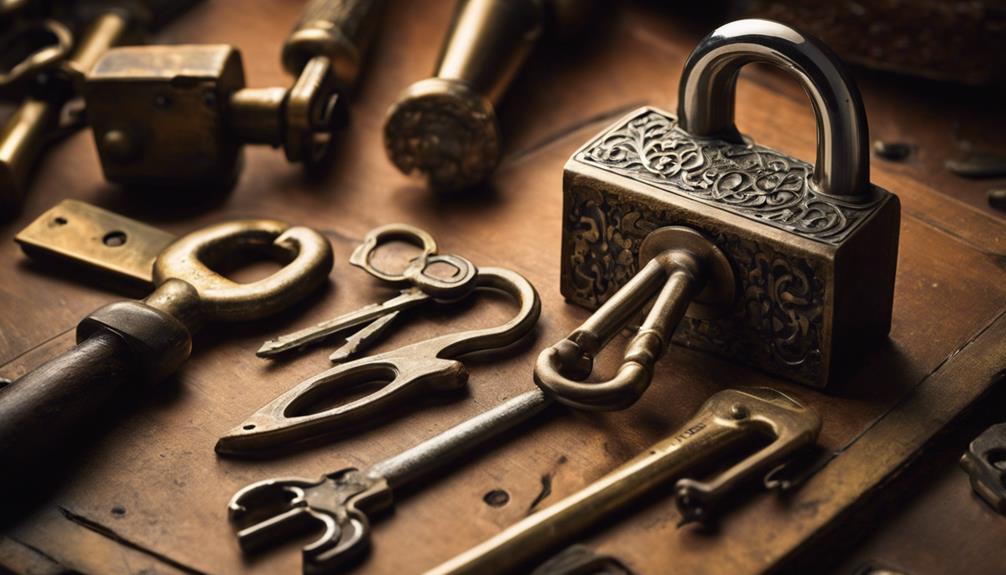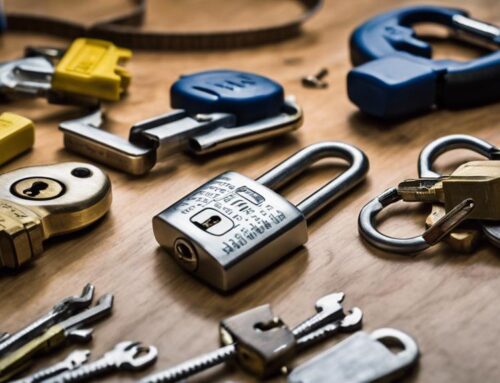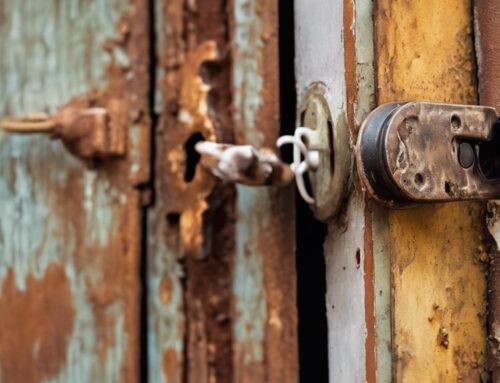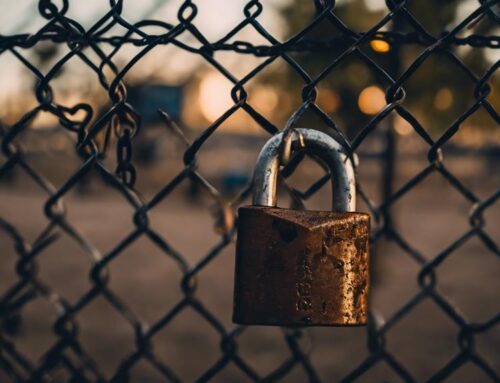When you rekey vintage locks, you're preserving their charm while boosting security. Start by evaluating their condition; check for wear, rust, and smooth operation. Choose a compatible keying system that maintains the lock's aesthetic appeal. You can opt for professional help for expert results or try a DIY approach if you're skilled. Make sure to enhance security features with durable materials and mechanisms that prevent easy duplication. Finally, testing your rekeyed locks for proper function is essential. There's plenty more to uncover about maintaining the integrity of your vintage locks while keeping them secure.
Key Takeaways
- Rekeying vintage locks enhances security while maintaining their historical charm, avoiding the need for complete lock replacements.
- Professional rekeying ensures expertise, preserving the integrity and functionality of vintage locks while minimizing potential errors.
- Assessing the condition of locks before rekeying helps identify any necessary repairs, ensuring optimal performance post-rekeying.
- Choosing compatible keying systems that align with vintage aesthetics is crucial for maintaining the locks' historical value.
- Regular maintenance, including cleaning and lubrication, prolongs the lifespan of vintage locks and ensures continued security.
Understanding Vintage Locks
Vintage locks are fascinating pieces of history that combine craftsmanship with security. When you explore these locks, you'll discover the intricate designs and materials that reflect a time when detail mattered.
Preserving these locks can be challenging, especially when considering preserving history while guaranteeing they remain functional. Understanding how to secure old locks is essential, especially if you want to maintain their functionality while preserving their charm.
Security rekeying vintage locks is a smart step if you've inherited or purchased antique pieces. This process guarantees that only you hold the key, protecting your home and valuables without compromising the lock's aesthetic appeal.
It's important to approach rekeying antique locks safely to preserve their integrity.
To secure old locks effectively, you should first assess their condition. Look for wear and tear that might require repair before rekeying.
It's wise to consult an expert familiar with vintage mechanisms, as they can provide valuable insights on preserving your locks' historical value while guaranteeing they operate smoothly.
Importance of Rekeying
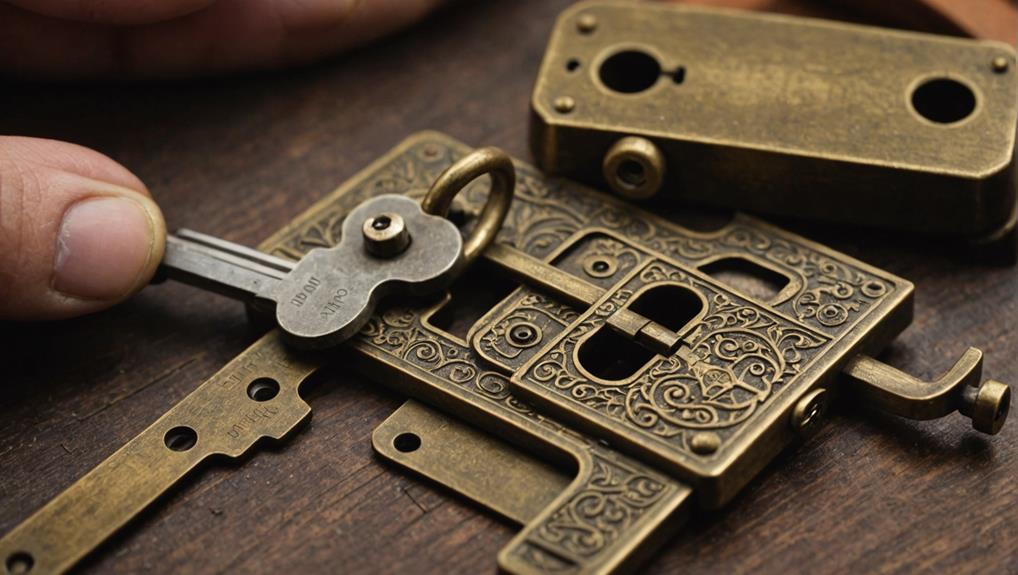
Rekeying your vintage locks is essential for enhancing their protection and ensuring your security.
This process not only offers peace of mind but also allows you to enjoy the benefits of cost-saving advantages without sacrificing the integrity of your vintage hardware.
It's a cost-effective way to keep your home safe without needing to replace the entire lock.
Plus, it allows you to maintain the historical charm of your vintage locks while updating their functionality.
Enhanced Lock Protection
One essential aspect of maintaining security in your home is ensuring that your locks are up to date, especially if they've been around for years.
Rekeying old locks securely not only enhances your vintage lock security but also provides peace of mind. You never know who might've had a key to your locks in the past, and rekeying can help protect your loved ones and possessions.
Here are some key benefits to take into account:
- Improved Security: Old keys might be circulating; rekeying eliminates that risk.
- Cost-Effective Upgrade: You don't need to replace the entire lock—just change the pins.
- Increased Control: You decide who gets access to your home.
- Preservation of Aesthetics: Keep your vintage locks while enhancing their functionality.
- Quick Process: Rekeying is usually a fast task, minimizing disruption.
Cost-Effective Security Solution
Considering the potential risks of outdated locks, rekeying offers a smart, cost-effective security solution for homeowners. Not only does it enhance your property's safety, but it also saves you money compared to replacing the entire lock system. Rekeying allows you to maintain the vintage aesthetic while upgrading your security effortlessly.
Here's a quick comparison of costs and benefits:
| Option | Cost | Benefits |
|---|---|---|
| Rekeying | Low | Maintains vintage look |
| Replacing Locks | High | Newer technology |
| Ignoring Security | Free | Risk of unauthorized access |
Historical Lock Preservation
Vintage locks aren't just functional pieces; they represent a rich history and craftsmanship that deserves preservation. When you rekey these locks, you're not only enhancing security but also honoring the stories they hold.
Each lock has its own tale, reflecting the era in which it was made and the artisans who crafted it. By rekeying, you guarantee these historical pieces remain both secure and relevant in modern times.
Consider the benefits of preserving vintage locks through rekeying:
- Enhanced Security: Protects your spaces while maintaining charm.
- Historical Value: Keeps the lock's original character intact.
- Sustainability: Reduces waste by reusing existing materials.
- Community Engagement: Encourages conversations about history and craftsmanship.
- Aesthetic Appeal: Adds unique character to your home or business.
Assessing Lock Condition

When evaluating the condition of your vintage locks, start with a thorough visual inspection to spot any signs of wear or damage. Look for rust, dents, or misalignment that could affect functionality.
After that, test the lock mechanism to guarantee it operates smoothly and efficiently. Additionally, consider whether the lock can be successfully re-keyed based on its design and condition, as the process of re-keying specialty locks may require specific expertise.
These steps will help you determine if re-keying is the right choice for maintaining security.
Visual Inspection Techniques
Evaluating the condition of a lock is essential, and a thorough visual inspection is your first step. This process helps you identify any visible issues that might compromise the lock's functionality and security.
When you're inspecting a vintage lock, keep an eye out for these key indicators:
- Rust or Corrosion: Look for any signs of rust that could affect the lock's operation.
- Cracks or Breaks: Check the body of the lock for any cracks, which can suggest weakness.
- Loose Components: Verify all parts, such as screws and bolts, are securely fastened.
- Signs of Wear: Pay attention to the wear on the keyhole and the housing, as significant wear can lead to malfunction.
- Color and Finish: Assess the lock's finish; any peeling paint or tarnish could indicate deterioration.
Testing Lock Mechanism
Regularly testing the lock mechanism is essential for verifying its reliability and security. By doing so, you'll identify potential issues before they become significant problems. Start by inserting the key and turning it several times. If you feel resistance or hear unusual noises, your lock may require attention.
Next, check the lock's alignment. A misaligned lock can lead to difficulties when locking or releasing. Confirm that the lock fits snugly within the door frame and doesn't wobble.
Lastly, consider the durability of the locking pins and cylinder. Worn components can compromise security. Here's a simple table to help you assess the condition of your lock:
| Test Type | What to Look For | Action Required |
|---|---|---|
| Key Insertion | Smooth turning | Lubricate or repair |
| Lock Alignment | Snug fit in door frame | Adjust or realign |
| Component Wear | Visible signs of wear/damage | Replace or restore |
Choosing the Right Keying System
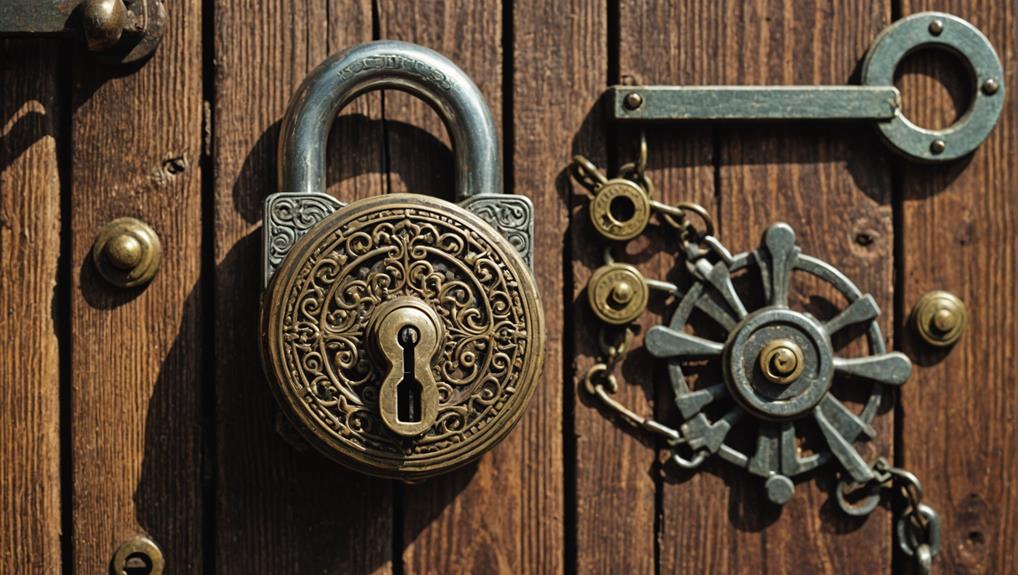
Selecting the right keying system is essential for maintaining both security and functionality in vintage locks. A proper understanding of lock re-keying benefits can help you make informed decisions as you choose the best system for your needs.
You'll want to take into account several factors to guarantee you choose a system that serves your needs effectively. A well-chosen keying system enhances security while preserving the charm of your vintage locks.
Here are some key points to reflect on:
- Compatibility: Verify the system works well with your specific lock type.
- Security Level: Opt for a system with higher security features, like restricted keyways or pin tumbler designs.
- Ease of Use: Choose a keying system that's user-friendly for everyone who'll be accessing the locks.
- Future Needs: Contemplate whether you might expand your locking system in the future and choose a scalable option.
- Aesthetic Appeal: Don't forget to reflect on how the keying system aligns with the vintage look of your locks.
Professional vs. DIY Rekeying

Weighing the options between professional and DIY rekeying can considerably impact the security and functionality of your vintage locks. When you choose to hire a professional, you're tapping into their expertise, ensuring that your locks are rekeyed correctly and securely. On the other hand, DIY rekeying can be a rewarding way to learn and save money, but it carries risks if you're not familiar with the process.
Here's a quick comparison to help you decide:
| Aspect | Professional Rekeying |
|---|---|
| Expertise | High, trained locksmiths |
| Time | Typically quicker |
| Cost | Higher upfront investment |
| Aspect | DIY Rekeying |
| Expertise | Varies, may require research |
| Time | Can be time-consuming |
| Cost | Lower, but potential errors |
Ultimately, your choice should align with your confidence in handling tools and your commitment to ensuring your vintage locks remain secure and functional. Whatever path you take, your effort in serving others' security will shine through.
Security Features to Consider

When it comes to vintage locks, understanding the security features available is vital for safeguarding your property. High-security locks offer advanced features that can greatly enhance protection, making them an excellent choice for securing vintage pieces.
You'll want to take into account several key elements that can improve the protection your vintage locks provide. Each feature plays a role in keeping your space secure while maintaining the charm of your vintage pieces.
- Material Quality: Confirm the lock is made from durable materials like brass or steel to resist tampering.
- Key Control: Verify how easily keys can be duplicated and whether you can limit key access, as high-security locks provide superior key control.
- Pick Resistance: Look for locks designed to resist picking, which can be a common method of unauthorized entry.
- Bump Resistance: Think about locks that are specifically made to withstand bumping, a technique used to open many locks quickly.
- Reinforced Strike Plates: Upgrade to strike plates that reinforce the lock against forced entry, adding an extra layer of security.
Testing Your Rekeyed Locks

After rekeying your vintage locks, it's essential to test them thoroughly to verify they function correctly and provide the security you need. Start by inserting the new key into each lock. It should slide in smoothly without resistance. Turn the key gently to see if it rotates fully. If it jams or feels stiff, you might need to adjust the pins inside the lock.
Mastering lock re-keying can help you understand the adjustments needed for a smooth operation.
Next, check the functionality of the lock itself. Lock and open each door several times to confirm consistency. Listen for any unusual sounds, like grinding or clicking, which may indicate misalignment or internal issues. Make sure the deadbolt extends fully and retracts without difficulty.
Don't forget to assess the security aspect. After testing, try using an old key to see if it still operates the lock. If it does, you may need to re-evaluate your rekeying process.
Maintenance for Long-Term Security

Maintaining your vintage locks is essential for guaranteeing their long-term security and functionality. Regular upkeep not only keeps your locks working smoothly but also helps prevent unauthorized access.
By dedicating a little time and effort, you can greatly enhance the lifespan of your locks and guarantee they continue to serve you well. Additionally, understanding the costs involved in lock re-keying can help you decide whether to handle maintenance yourself or hire a professional for lock re-keying costs when necessary.
Here are some key maintenance tips to reflect on:
- Clean Regularly: Dust and debris can accumulate, so clean the locks with a soft cloth to keep them free from dirt.
- Lubricate: Use a graphite or silicone-based lubricant to keep the internal mechanisms moving smoothly.
- Check for Wear: Regularly inspect your locks for any signs of wear or damage. Replace components as needed.
- Tighten Screws: Confirm that all screws and fittings are secure. Loose components can compromise security.
- Keep Spare Keys Safe: Store spare keys in a secure place to avoid unauthorized access.
Frequently Asked Questions
Can I Use Modern Keys With Vintage Locks?
You might find that modern keys don't fit vintage locks properly.
These locks were designed with unique shapes and mechanisms that differ from today's standards.
If you're looking to use modern keys, consider having a locksmith assess the lock.
They can often modify the lock or create a custom key to work seamlessly.
This way, you can keep the charm of your vintage piece while ensuring it functions effectively for your needs.
How Often Should I Rekey My Vintage Locks?
Imagine walking through a charming old home, each lock a tribute to history.
You should rekey your vintage locks every few years, or sooner if you've lost a key. This way, you guarantee the safety of your cherished space.
Regular rekeying not only keeps your home secure but also honors the craftsmanship of those vintage pieces.
Will Rekeying Affect the Lock's Value?
Rekeying can definitely affect a lock's value, especially if it's vintage.
When you rekey, you're changing its original configuration, which some collectors might view as a loss of authenticity.
If you're looking to maintain or increase its value, it's best to carefully consider this decision.
However, if security is your priority, rekeying might be worth it.
Just weigh the pros and cons, and remember that condition and originality often matter most to collectors.
What Tools Are Essential for Rekeying Vintage Locks?
When you're rekeying vintage locks, having the right tools is essential.
You'll need a rekeying kit specific to the lock brand, a set of small screwdrivers, and a pinning tray to keep everything organized.
A pair of tweezers can help you handle tiny parts, while a flashlight guarantees you see what you're doing.
Don't forget lubricant to keep things running smoothly.
With these tools, you can effectively and safely rekey those cherished locks.
Are There Specific Vintage Lock Brands to Avoid When Rekeying?
When rekeying vintage locks, you'll want to avoid brands known for fragile components or poor quality.
Brands like Corbin and Yale, while reputable, can have specific models that don't hold up well under the rekeying process.
It's best to research and consult with experts to identify which locks are worth your time and effort.
Always prioritize durability to guarantee the locks function securely and efficiently for those you're serving.
Conclusion
Rekeying vintage locks is like tuning a classic car; it keeps your security running smoothly while preserving its timeless charm. By understanding the intricacies of vintage locks and evaluating their condition, you can confidently choose the right keying system. Whether you opt for professional help or tackle it yourself, regular maintenance will guarantee your locks remain reliable. So, take the time to rekey and protect your treasures, ensuring they're safe for years to come.

